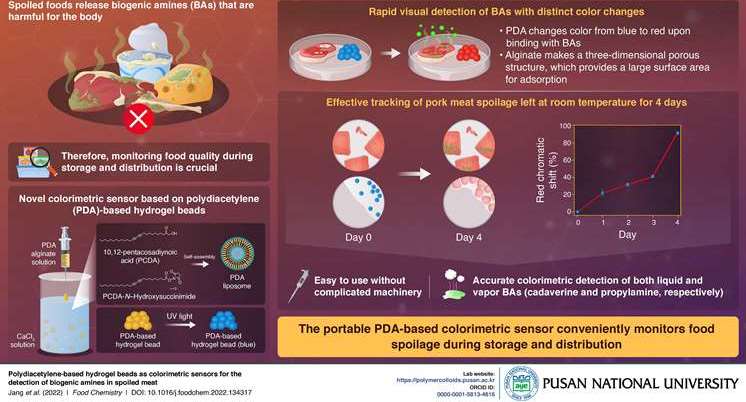Ingesting biogenic amines released from spoiled food is harmful for the human body. Thus, it is important to detect these compounds during food storage and distribution to track spoilage. To this end, researchers have now combined polydiacetylene liposome and alginate solution to create hydrogel for developing a colourimetric food spoilage sensor. This novel sensor easily detects biogenic amines in liquid or vapour form by changing colour from blue to red, without any complicated machinery.
When foods like fish, meat, and cheese decompose, they release a variety of low molecular weight organic nitrogen compounds known as biogenic amines (BAs). While the body uses BAs in small amounts in processes like hormone synthesis, ingesting large amounts of BAs from spoiled food can cause serious health problems. Therefore, it is important to detect BAs during food storage and distribution. This motivated a team of researchers to develop a portable molecular sensor that quickly detects the presence of BAs by changing colours.
Said Prof. Sungbaek Seo, Associate Professor of Biomaterials Science at Pusan National University: “The rapid and easy monitoring of deleterious BAs released from spoiled foods could alert us, prevent consumption of spoiled meat, maintain food quality, and establish further effective food storage and distribution conditions in the logistic chain.”
The sensor is made of portable, light-weight beads and does not require complicated analytical equipment or skilled personnel. It offers rapid and seamless visual detection via colourimetric change in the beads from blue to red.
Concluded Prof. Seo: “The portable beads could be utilised on sites for monitoring whether the food quality is okay during storage and logistic chain. Further, the beads could be applied in evaluating whether ideal food storage and distribution conditions are well-preserved.”
Taken together, this portable PDA-based colorimetric sensor would facilitate the seamless monitoring of food spoilage during storage and distribution, and prevent health hazards arising from the ingestion of BAs. For more visit pusan.ac.kr/eng/Main.do










